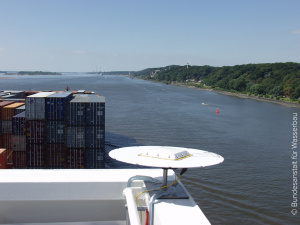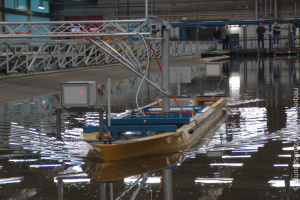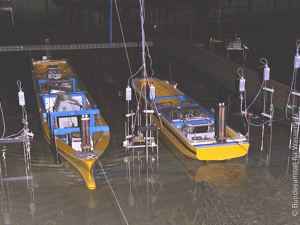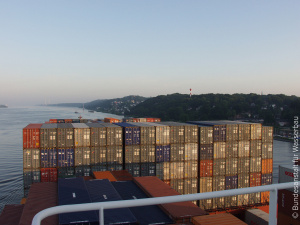Ship Dynamics: Difference between revisions
From BAWiki
imported>Spohr Susanne mNo edit summary |
The LinkTitles extension automatically added links to existing pages (<a target="_blank" rel="nofollow noreferrer noopener" class="external free" href="https://github.com/bovender/LinkTitles">https://github.com/bovender/LinkTitles</a>). |
||
| (6 intermediate revisions by one other user not shown) | |||
| Line 1: | Line 1: | ||
[[de:Schiffsdynamik]] | [[de:Schiffsdynamik]] | ||
[[File: BAWiki_Schiffsdynamik_1.jpg|thumb|Picture 1: Investigations on ship dynamics of large vessels in approach channels]] | |||
[[File: BAWiki_Schiffsdynamik_2.jpg|thumb|Picture 2: Highly developed measuring equipment to detect ship dynamics in scaled models]] | |||
[[File: BAWiki_Schiffsdynamik_3.jpg|thumb|Picture 3: Head-on traffic in scaled model]] | |||
[[File: BAWiki_Schiffsdynamik_4.jpg|thumb|Picture 4: Cumulative curve of the additional squat at head-on traffic in approach channels]] | |||
[[File: BAWiki_Schiffsdynamik_5.jpg|thumb|Picture 5: Measurement of the ship dynamic in the approach channel of the tidal river Elbe]] | |||
The following text reduces the meaning of "dynamic behaviour" to the vertical movements of the ship (squat and [[trim]]) with the effects in terms of vessel size, ship speed and bed structures. | |||
Squat refers to the way the moving ship is lowered in the [[primary wave]] system generated by the ship itself. [[Trim]] is the way the ship turns around the pitch axis and is influenced among others by certain ship parameters and the ship speed. The purpose of the studies is to provide the WSV with the squat and [[trim]] parameters related to speed, [[water level]] and [[draught]] for determining the [[fairway]] depths for pending upgrading projects. The [[model]] studies are divided into three sub-projects: | |||
Selected results of the extensive test series are presented under the above numbers. Picture 1 gives and impression of the test facility and the size of the model ships. | *Determining squat and [[trim]] together with ship-induced pressure and wave systems when travelling over a firm, level bed in laterally unrestricted [[shallow water]] | ||
*Determining squat and [[trim]] together with ship-induced pressure and wave systems when travelling over a firm bed with dunes in laterally unrestricted [[shallow water]] | |||
*Systematic studies for determining squat and [[trim]] together with ship-induced pressure and wave systems when passing through channels in laterally restricted [[shallow water]]. | |||
Selected results of the extensive test series are presented under the above numbers. Picture 1 gives and impression of the test facility and the size of the [[model]] ships. | |||
The results of the studies under 1 and 2 were published in March 2001 (Uliczka/Flügge, 2001) and in September and December 2001 (Flügge/Uliczka, 2001). Results of the studies under 3 were published in January 2004 (Uliczka/Kondziella/Flügge, 2004) and in 2006 (Uliczka/ Kondziella, 2006). | The results of the studies under 1 and 2 were published in March 2001 (Uliczka/Flügge, 2001) and in September and December 2001 (Flügge/Uliczka, 2001). Results of the studies under 3 were published in January 2004 (Uliczka/Kondziella/Flügge, 2004) and in 2006 (Uliczka/ Kondziella, 2006). | ||
The increasing sizes of seagoing ships and the navigability analyses that thus have to be done on tidal estuaries mean that the task of investigating the interaction between a seagoing ship and the tidal [[fairway]] has required, among other things, ongoing research into the dynamics of a ship as it passes approach channels in respect of the physical bases for the “tool” of [[Ship Handling Simulation|ship handling simulation]]. This field of research has thus been enhanced with the addition of two sub-projects – the interaction between ship and [[bank]] (Bernoulli or [[bank]] effect) and that between two ships – together with the “vertical” dynamics of squat and [[trim]] (see above). As well as the parameters of ship-generated [[water level]] deflection and current, which have always been required, and the speed-dependent squat and [[trim]], the sub-projects also determine the speed-dependent forces and torques acting laterally on the ship. | |||
*The „[[bank]]-effect“ sub-project determined the interaction between seagoing ships and various embankments by determining distance- and [[gradient]]-dependent transverse forces and yaw torques in a physical [[model]] test. | |||
*The ongoing “ship/ship interaction” sub-project is working on calculating the speed-dependent transverse forces and yaw torques as well as the dynamic squat and [[trim]] when exceptionally large container ships meet depending on their clearance and [[draught]] and the [[water level]]. Both physical [[model]] tests(EFD: Experimental Fluid Dynamics) and hydrodynamic-numerical calculations (CFD: Computational Fluid Dynamics) are being undertaken. | |||
*The ship-generated deflections in the [[water level]] (ship waves) and currents, which are to be determined at the same time as the other parameters, enable a complete picture to be painted of the physical processes occurring as the ships pass through the [[channel]]. | |||
The sub-projects mainly used and continue to use the hydraulic scale test method in accordance with the state of the art in order to detect ship dynamics data for the large vessels as well as to generate underlying data for the [[Ship Handling Simulation|ship handling simulation]] and validation data for further developing hydrodynamic-[[Numerical Methods|numerical methods]]. | |||
==literature== | |||
*''Uliczka, K. und Flügge, G., Squat-Untersuchungen für sehr große Postpanmax-Containerschiffe, Tagungsband HTG-Sprechtag des FA Seeschifffahrtsstraßen, Hafen und Schiff, Hamburg, 27. März 2001'' | |||
*''Flügge, G. und Uliczka, K., Dynamisches Fahrverhalten und Wechselwirkungen mit der Fahrrinnensohle von sehr großen Containerschiffen unter extremen Flachwasserbedingungen, Tagungsband HTG-Kongress Häfen & Wasserstraßen, Hamburg, September 2001'' | |||
*''Flügge, G. und Uliczka, K., Dynamisches Fahrverhalten und Wechselwirkungen mit der Fahrrinnensohle von sehr großen Containerschiffen unter extremen Flachwasserbedingungen (mit weiteren Ergebnissen), HANSA 138. Jhrg. Dezember 2001'' | |||
*''Uliczka, K., Kondziella, B. und Flügge, G., Dynamisches Fahrverhalten sehr großer Containerschiffe in seitlich begrenztem extremen Flachwasser, HANSA 141. Jhrg. Januar 2004'' | |||
*''Uliczka, K. und Kondziella, B., Dynamic response of very large containerships in extremly [[shallow water]], Proceedings of the 31st PIANC Congress, Estoril, Spanien, 2006'' | |||
*''Uliczka, K., Seeschiffe auf Seeschifffahrtsstraßen am Beispiel der Unter und Außenelbe. In: Hamburg – die Elbe und das Wasser sowie weitere wasserhistorische Beiträge. Schriften der DWhG Band 13, S. 97-112, Siegburg, 2009'' | |||
*''Uliczka, K., Kondziella, B., Research on ship dynamics on large containerships in confined fairways. International Conference on Ship Manoeuvring in Shallow and Confined Water – [[Bank]]-Effects - Antwerp. In: Conference Proceedings of RINA, Ghent University, FHR, RINA, London, 2009'' | |||
*''Briggs, M. J., Vantorre, M., Uliczka, K. und Debaillon, P., Prediction of Squat for Underkeel Clearance. In: Handbook of Coastal and [[Ocean]] Engineering, World Scientific Publishing Co. Pte. Ltd., Singapore, 2010'' | |||
*''Uliczka, K., Böttner, C-U. und Carstens, D., Head-on traffic at the approach [[channel]] to the [[Port]] of Hamburg. 3rd International Conference on Ship Manoeuvring in Shallow and Confined Water – Ships Behaviour in Locks - Ghent. In: Conference Proceedings of RINA, Ghent University, FHR, RINA London, 2013'' | |||
*''Uliczka, K., Wasserbauliche Modellversuche zur Wechselwirkung Seeschiff / Seeschifffahrtsstraße. In: 44. Internationales Wasserbau-Symposium Aachen 2014, RWTH Aachen, IWW, Achen, 2014'' | |||
*''Gourly, T.P., Ha, J.H., Mucha, P. und Uliczka, K., Sinkage and [[Trim]] of Modern Container Ships in [[Shallow water|Shallow Water]]. In: Proceedings, Australasian Coasts & Ports Conference 2015, Auckland, New Zealand, 2015'' | |||
---- | ---- | ||
Latest revision as of 09:13, 21 October 2022





The following text reduces the meaning of "dynamic behaviour" to the vertical movements of the ship (squat and trim) with the effects in terms of vessel size, ship speed and bed structures.
Squat refers to the way the moving ship is lowered in the primary wave system generated by the ship itself. Trim is the way the ship turns around the pitch axis and is influenced among others by certain ship parameters and the ship speed. The purpose of the studies is to provide the WSV with the squat and trim parameters related to speed, water level and draught for determining the fairway depths for pending upgrading projects. The model studies are divided into three sub-projects:
- Determining squat and trim together with ship-induced pressure and wave systems when travelling over a firm, level bed in laterally unrestricted shallow water
- Determining squat and trim together with ship-induced pressure and wave systems when travelling over a firm bed with dunes in laterally unrestricted shallow water
- Systematic studies for determining squat and trim together with ship-induced pressure and wave systems when passing through channels in laterally restricted shallow water.
Selected results of the extensive test series are presented under the above numbers. Picture 1 gives and impression of the test facility and the size of the model ships.
The results of the studies under 1 and 2 were published in March 2001 (Uliczka/Flügge, 2001) and in September and December 2001 (Flügge/Uliczka, 2001). Results of the studies under 3 were published in January 2004 (Uliczka/Kondziella/Flügge, 2004) and in 2006 (Uliczka/ Kondziella, 2006).
The increasing sizes of seagoing ships and the navigability analyses that thus have to be done on tidal estuaries mean that the task of investigating the interaction between a seagoing ship and the tidal fairway has required, among other things, ongoing research into the dynamics of a ship as it passes approach channels in respect of the physical bases for the “tool” of ship handling simulation. This field of research has thus been enhanced with the addition of two sub-projects – the interaction between ship and bank (Bernoulli or bank effect) and that between two ships – together with the “vertical” dynamics of squat and trim (see above). As well as the parameters of ship-generated water level deflection and current, which have always been required, and the speed-dependent squat and trim, the sub-projects also determine the speed-dependent forces and torques acting laterally on the ship.
- The „bank-effect“ sub-project determined the interaction between seagoing ships and various embankments by determining distance- and gradient-dependent transverse forces and yaw torques in a physical model test.
- The ongoing “ship/ship interaction” sub-project is working on calculating the speed-dependent transverse forces and yaw torques as well as the dynamic squat and trim when exceptionally large container ships meet depending on their clearance and draught and the water level. Both physical model tests(EFD: Experimental Fluid Dynamics) and hydrodynamic-numerical calculations (CFD: Computational Fluid Dynamics) are being undertaken.
- The ship-generated deflections in the water level (ship waves) and currents, which are to be determined at the same time as the other parameters, enable a complete picture to be painted of the physical processes occurring as the ships pass through the channel.
The sub-projects mainly used and continue to use the hydraulic scale test method in accordance with the state of the art in order to detect ship dynamics data for the large vessels as well as to generate underlying data for the ship handling simulation and validation data for further developing hydrodynamic-numerical methods.
literature
- Uliczka, K. und Flügge, G., Squat-Untersuchungen für sehr große Postpanmax-Containerschiffe, Tagungsband HTG-Sprechtag des FA Seeschifffahrtsstraßen, Hafen und Schiff, Hamburg, 27. März 2001
- Flügge, G. und Uliczka, K., Dynamisches Fahrverhalten und Wechselwirkungen mit der Fahrrinnensohle von sehr großen Containerschiffen unter extremen Flachwasserbedingungen, Tagungsband HTG-Kongress Häfen & Wasserstraßen, Hamburg, September 2001
- Flügge, G. und Uliczka, K., Dynamisches Fahrverhalten und Wechselwirkungen mit der Fahrrinnensohle von sehr großen Containerschiffen unter extremen Flachwasserbedingungen (mit weiteren Ergebnissen), HANSA 138. Jhrg. Dezember 2001
- Uliczka, K., Kondziella, B. und Flügge, G., Dynamisches Fahrverhalten sehr großer Containerschiffe in seitlich begrenztem extremen Flachwasser, HANSA 141. Jhrg. Januar 2004
- Uliczka, K. und Kondziella, B., Dynamic response of very large containerships in extremly shallow water, Proceedings of the 31st PIANC Congress, Estoril, Spanien, 2006
- Uliczka, K., Seeschiffe auf Seeschifffahrtsstraßen am Beispiel der Unter und Außenelbe. In: Hamburg – die Elbe und das Wasser sowie weitere wasserhistorische Beiträge. Schriften der DWhG Band 13, S. 97-112, Siegburg, 2009
- Uliczka, K., Kondziella, B., Research on ship dynamics on large containerships in confined fairways. International Conference on Ship Manoeuvring in Shallow and Confined Water – Bank-Effects - Antwerp. In: Conference Proceedings of RINA, Ghent University, FHR, RINA, London, 2009
- Briggs, M. J., Vantorre, M., Uliczka, K. und Debaillon, P., Prediction of Squat for Underkeel Clearance. In: Handbook of Coastal and Ocean Engineering, World Scientific Publishing Co. Pte. Ltd., Singapore, 2010
- Uliczka, K., Böttner, C-U. und Carstens, D., Head-on traffic at the approach channel to the Port of Hamburg. 3rd International Conference on Ship Manoeuvring in Shallow and Confined Water – Ships Behaviour in Locks - Ghent. In: Conference Proceedings of RINA, Ghent University, FHR, RINA London, 2013
- Uliczka, K., Wasserbauliche Modellversuche zur Wechselwirkung Seeschiff / Seeschifffahrtsstraße. In: 44. Internationales Wasserbau-Symposium Aachen 2014, RWTH Aachen, IWW, Achen, 2014
- Gourly, T.P., Ha, J.H., Mucha, P. und Uliczka, K., Sinkage and Trim of Modern Container Ships in Shallow Water. In: Proceedings, Australasian Coasts & Ports Conference 2015, Auckland, New Zealand, 2015
back to Hydraulic Modelling
